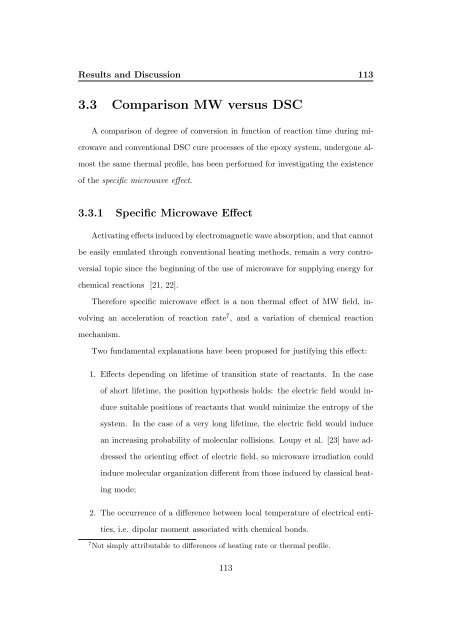Kinetic Analysis and Characterization of Epoxy Resins ... - FedOA
Kinetic Analysis and Characterization of Epoxy Resins ... - FedOA
Kinetic Analysis and Characterization of Epoxy Resins ... - FedOA
Create successful ePaper yourself
Turn your PDF publications into a flip-book with our unique Google optimized e-Paper software.
Results <strong>and</strong> Discussion 113<br />
3.3 Comparison MW versus DSC<br />
A comparison <strong>of</strong> degree <strong>of</strong> conversion in function <strong>of</strong> reaction time during microwave<br />
<strong>and</strong> conventional DSC cure processes <strong>of</strong> the epoxy system, undergone almost<br />
the same thermal pr<strong>of</strong>ile, has been performed for investigating the existence<br />
<strong>of</strong> the specific microwave effect.<br />
3.3.1 Specific Microwave Effect<br />
Activating effects induced by electromagnetic wave absorption, <strong>and</strong> that cannot<br />
be easily emulated through conventional heating methods, remain a very controversial<br />
topic since the beginning <strong>of</strong> the use <strong>of</strong> microwave for supplying energy for<br />
chemical reactions [21, 22].<br />
Therefore specific microwave effect is a non thermal effect <strong>of</strong> MW field, involving<br />
an acceleration <strong>of</strong> reaction rate 7 , <strong>and</strong> a variation <strong>of</strong> chemical reaction<br />
mechanism.<br />
Two fundamental explanations have been proposed for justifying this effect:<br />
1. Effects depending on lifetime <strong>of</strong> transition state <strong>of</strong> reactants. In the case<br />
<strong>of</strong> short lifetime, the position hypothesis holds: the electric field would induce<br />
suitable positions <strong>of</strong> reactants that would minimize the entropy <strong>of</strong> the<br />
system. In the case <strong>of</strong> a very long lifetime, the electric field would induce<br />
an increasing probability <strong>of</strong> molecular collisions. Loupy et al. [23] have addressed<br />
the orienting effect <strong>of</strong> electric field, so microwave irradiation could<br />
induce molecular organization different from those induced by classical heating<br />
mode;<br />
2. The occurrence <strong>of</strong> a difference between local temperature <strong>of</strong> electrical entities,<br />
i.e. dipolar moment associated with chemical bonds.<br />
7 Not simply attributable to differences <strong>of</strong> heating rate or thermal pr<strong>of</strong>ile.<br />
113
















